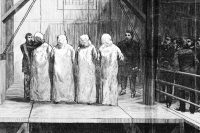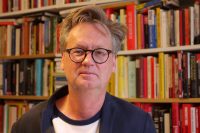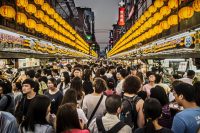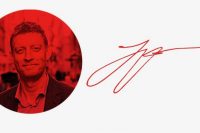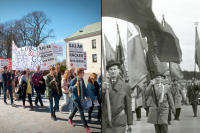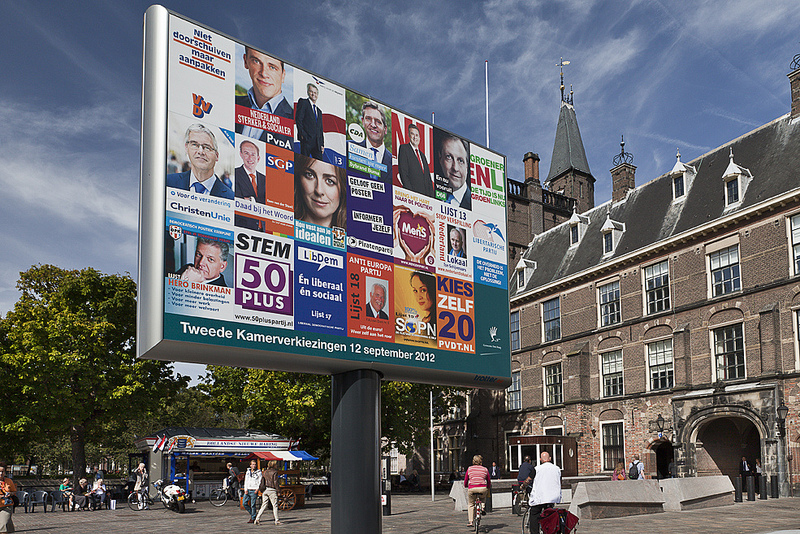
The Dutch political laboratory is alive and kicking. Populist actors may have taken past headlines but the election marked the dramatic return of the pro-European centre ground.
‘The political centre is back’, ‘Again the purple coalition of red and blue’, ‘Voters want cooperation. Not polarisation’: these are some of the headlines of Dutch newspapers the morning after the spectacular results in the Dutch election of September 12th.
Less than three weeks ago, when the international press went over, en masse, for the start of the election campaign of Emile Roemer, the leader of the de-radicalised radical left Socialist Party, other headlines would have been expected: ‘‘Dutch election results endanger euro’’; ‘‘Germany loses it’s strict fiscal policies ally’’, ‘‘The Dutch oppose further transfers to Greece and Spain’’. ‘‘Currency union under serious threat because of financial markets’ response of the to Dutch election result’’.
The international press was tricked and alarmed by the August polls, in which the Dutch elections would seemingly become a neck-and-neck contest between the anti-neoliberal, euroskeptic Socialist Party of Emile Roemer and the conservative-liberal party VVD of incumbent Prime Minister Mark Rutte. In some polls, the SP was even the biggest party. What would that mean for the Dutch position in Europe and in terms of room for manoeuvre for rescuing the euro?
As we now know from the international news headlines, this last scenario was way off target. Not the SP, but the centre-left Dutch Labour Party PvdA became the main contender to the right-wing VVD and prime minister Mark Rutte in the election campaign. This was due to an unprecedented ‘come-back-kid’ campaign by the PvdA leader Diederik Samsom who surprised everyone with his great performances in television debates, by telling, prime ministerially, ‘the honest, complex, hard story’ about the dilemma’s the Netherlands is facing (eurocrisis, demographic shifts, need for ecological innovation, cost-of-care explosion, housing market bubble).
At the same time, Emile Roemer, who was liked by everyone, performed badly and failed the test. The dynamics of everyday polling, television debates and social media-pressure produced a two horse race, never seen before: elect the Prime Minister of the Left, Diederik Samsom, or the Prime Minister of the Right, Mark Rutte. This provoked in the last week of the campaign, and on election day itself, strategic voting to the max, in the process ‘eating away’ at the smaller parties. The left-wing greens GroenLinks, for example, lost seven of their 10 seats!
In a very close race, the VVD ended up with 41 seats and Labour with 39, giving them a combined 80 seats in the 150-seat parliament. The SP did not gain any extra seats, but retained all of it’s 15 seats. Geert Wilders’ Freedoms Party PVV lost heavily: campaigning on an aggressive anti-Europe ticket, they won only 15 seats – down nine from their previous total.
So, the actual election results differed greatly from the virtual reality of earlier polling. What happened? Before I try to make some interpretations and explanations about the surprising return to the political centre, I first have to say, that this post-election analysis is literally written the morning after, and therefore far too early and unripe. It carries the traces of an election night-hangover – more alcoholically than politically. In the famous pop music temple Paradiso in Amsterdam, the PvdA had it’s election night party. And although it was a disappointment that, after a nightlong cliffhanger, the VVD turned out to be the biggest party by just one seat, the mood in Paradiso was fantastic. I’ve never seen so many PvdA-people smiling in my life. The most emotional moment was, when after the (near) victory speech of Diederik Samsom, Wim Kok, Wouter Bos and Job Cohen – the former party leaders – entered the stage. Political banana skin-moment: Clinton meets Obama on tiny Dutch scale.
The story about the 12th of September elections is a story of two tales. One, of spectacular and alarming polls up to three weeks before the election – predicting an historic collapse of the political centre. And a second story of the so-called ‘hot phase’ of the election campaign, in which one pillar of the political centre – the Dutch Labour party (PvdA) – managed to overcome an unprecedented existential threat of defeat.
The PvdA not only risked becoming a party too small for pretending to be a ‘Volkspartei’ (people’s party) any more, it also risked being overtaken in terms of parliamentary seats by its main competitor; the de-radicalised radical-left Socialist Party. That would have been an historic disaster for the PvdA, standard barer for more than 100 years of Dutch social democracy (1894). By way of sheer campaign miracles, the PvdA’s leader Diederik Samsom, in the last two weeks of the campaign, was able to beat back his party’s main contender, SP, closing a gap of 15 seats.
The relief in Paradiso was therefore massive. The PvdA is still alive and kicking. The people’s party is not over yet. The political centre can beat populist flanks. The conservative-liberal direction of the country can be moved to the centre-left. The negative energy around immigration and Europe can be turned into something more positive and constructive. Those were the ingredients of relief in Paradiso.
Is there a bigger picture? ‘‘Every Dutch election has been at the forefront of what is the mood everywhere in Europe’’, said political analyst Piotr Maciej Kaczynski of the Center for European Policy studies’ to the Associated Press. In a similar fashion, Frankfurter Allgemeine Zeitung quoted German FDP-politician Otto Fricke saying, that trends in the Netherlands one way or the other arrive in its big eastward Neighbour’’. Ian Traynor of the Guardian put it this way: ‘‘The Dutch election is being watched closely in Brussels and across Europe not only for the message a founding EU member sends about the union’s worst-ever crisis, but because Dutch politics are often a reliable gauge of broader European political trends, from the rise of maverick populists a decade ago, to the referendum rejection of a European constitution in 2005.’’
These three separate sources warn of the Holland laboratory, for the Dutch avant-garde experience: what occurs in Dutch politics and society, will – sooner or later – impact society and politics in the surrounding countries of the Netherlands.
The Netherlands has become over the years a laboratory of electoral volatility, political fragmentation and the rise of all sorts of populism. Under the pressures of globalisation, de-traditionalisation and post-industrialism, the post-war stability of the party political system has been seriously eroded. The christian-democratic and social-democratic people’s parties, once strong pillars of the Dutch welfare state, weakened dramatically. The political centre has been under heavy pressure.
New political entrepreneurs, exploiting the tensions and fears of a turbulent and changing society, have jumped into the political vacuum. They have become household names in the debate about the vulnerability of European politics: Pim Fortuyn and Geert Wilders.
This election may now be a big turning point again. Some speak already about the end of the Dutch Populist Era since Pim Fortuyn’s rise in 2002. It was the Third Way-ish purple coalition of Wim Kok (a coalition of red PvdA and blue VVD, and social-liberal D66) that – by eroding the traditional left/right divide – produced a populist backlash. Now the circle is round: the populist era may end with a new purple coalition, because the election results force nearly inevitably a coalition between the political opponents Mark Rutte (VVD) and Diederik Samsom (PvdA).
The basic elements of the election campaign resemble the 2010 election: the predominant role of the economic Central Planning Bureau, the polls and the debates on television. Fact checking became a national sport: do politicians tell the truth in televised debates?
These elections were not so much a referendum about the EU or the EMU, but focused mainly on the type of European crisis management, the policy choices needed to reduce the deficit and get the economy back on track, and the future of crucial welfare state arrangements. Within the limits of a broad technocratic financial consensus, the political choice was at stake to stay on the liberal-conservative track, or to change to the social democratic one. The outcome of the elections is undecided. The Dutch voters voted for both alike. Evidently, the return to the political centre, away from the left-wing populist (SP) and right-wing populist (PVV) flanks, means the pragmatic embracing of a more pro-European position.
The return of the political centre may also be a bit of wishful thinking. Both PvdA and VVD shifted in their programme and rhetorical management of voter’s expectation to the left and right side. The PvdA was called SP-light; the VVD acted as a kind of PVV-light. So the voters voted for ‘‘the extremes within the mainstream’’. They did not vote for the traditional political middle of Dutch politics. For example, the Christian-Democratic CDA, the pillar of the Dutch welfare state and poldermodel, lost heavily to the VVD. It may be that we experience the end of Christian politics in the Netherlands, 40 years after secularisation made its mark. So it remains to be seen what kind of political centre politics will arrive from a possible coalition of the VVD and PvdA, and if this new political centre will or will not provoke new populist discontent on the flanks, but instead take the great opportunity to integrate and pacify the flanks into the political mainstream again.
Finally, the campaign again revealed the extreme volatility of the Dutch voter. Up until two days before the election some 40% of the electorate was reported not to have known who to vote for. So given this volatility, it remains hard to draw analytical conclusions beyond the day courses of polling and media-hype.
René Cuperus is senior research fellow and deputy director at the Wiardi Beckman Stichting, the thinktank of the Dutch Labour Party (with thanks to Frans Becker).
Fotnot: Texten har publicerats av tankesmedjan Policy Network och återpubliceringen sker med tillstånd av författaren och Policy Network, vars bevakning av europeisk progressiv politik – ”State of the Left” – du kan följa här.
Följ Dagens Arena på Facebook och Twitter, och prenumerera på vårt nyhetsbrev för att ta del av granskande journalistik, nyheter, opinion och fördjupning.










